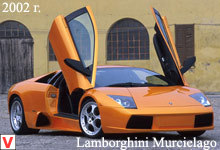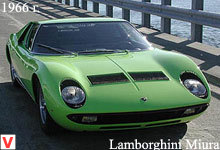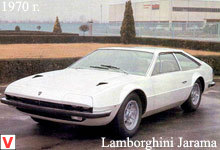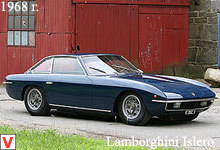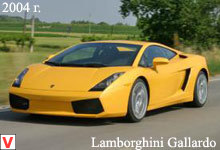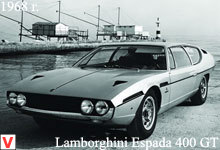
In the 80s, the legendary model Countach was noticeably outdated. Lamborghini faces the challenge of creating a worthy successor. So Lamborghini Diablo was born. The presentation of the model took place in January 1990 in Monte Carlo, where the car made a real sensation. Above the look worked recognized master of his work Marcello Gandini. When the Lamborghini company passed under the wing of Chrysler, American specialists took an active part in the design development. The appearance of the Diablo reflected the style directions of the early 90s, they deprived the car of angular aggressiveness, but made it more refined, sleeker and more extravagant compared to its predecessor.
The stylish wedge-shaped profile and the giant “wings” of the hood have driven people of all countries and continents crazy. In the best traditions of Italian supercars, Diablo has a welded space frame made of steel pipes. All wheel suspension independent, double wishbone, and the engine is located longitudinally behind the driver. The car has undergone comprehensive tests and tests, its reliability did not cause any complaints, with all its explosive character it had good handling. In the role of the main driving force V12 engine volume of 5709 cm ³ capacity 492 hp (367 kW). The power unit had a double overhead camshaft (DOHC) and an electronic fuel injection system.

The speed of the Diablo, as stated by the company, was 323 km / h. Despite the relatively high cost, the range of options offered was minimal - a simple radio (optional installed CD-player), manual windows, the lack of an anti-lock braking system (ABS). The official position of Lamborghini on this subject - the car should be as light as possible, because its mass is 1625 kilograms. But, nevertheless, some options were available additionally. Sales of the first version of Diablo began in 1991 and continued until 1993. In 1993, the base model underwent some changes.
Lamborghini decided that an improved version of the car could attract new customers. She received the designation Diablo VT (Viscous Traction) - "viscous traction", translated from English. The model was equipped with a central viscous coupling, transmitting 27% of the torque to the front wheels. Visually, changes were manifested in an increase in the size of air intakes near the rear wheels, updating the dashboard and the appearance of a groove in a fairly high engine compartment cover. This chute allowed you to see what was happening behind through the rear-view mirror.
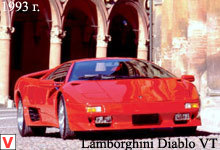
From 1995 to 1998, the Diablo SV (Sport Veloce) modification was made and sold - “fast, sporty”, translated from Italian. This Lamborghini left the drive only on the rear wheels. The updated serial engine began to develop power 510 hp The Diablo SV has a new dashboard, enhanced brakes, a customizable spoiler and dual air intakes.
The front and rear bumpers have also been redesigned. On each side of the car, a large “SV” emblem was placed on the door. The alcantara leather-covered saloon was sporty-styled, the passenger airbag was not installed until 1998, when it came as standard. German masters of tuning from Auto König engaged in refining Diablo SV. They created their own modification of this model with a more serious braking system and a twin turbocharger. This allowed to increase the engine power up to 800 hp (597 kW). In 1994, sales of the Diablo SE30 started.
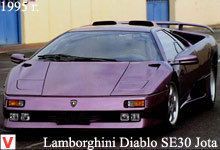
Special Edition in honor of the 30th anniversary of the Lamborghini. This limited series consisted of 150 cars, eight of them equipped with the right-hand drive. In 1995, the company introduced the Diablo SE30 Jota. The main difference of this modification is 2 original air intakes in the rear part of the car roof (for this reason it was necessary to abandon the rear-view mirror in the cabin). The gearbox has become fully synchronized. Improvements to the engine allowed to raise its power to 595 hp (at 7300 rpm) leaving the working volume unchanged. All four wheels were equipped with disc brakes with a larger area of disks and pads, but ABS still did not exist.
To facilitate the car, everything that was not directly related to driving was removed from it — air conditioning, a radio tape recorder, and even branded seats made of pressed carbon fiber. This allowed to reduce the total weight of the machine by 125 kg, compared with the standard version. Accurate data has not been preserved, but there are assumptions that a total of 10 SE30 Jota were made with the left rudder and 2 with the right.

The open exhaust system was standard for Jota, which is not allowed in all countries and makes it impossible to register a car for road use. The car could not be fully used off-road, but several copies were seen on public roads. In 1995, the Bologna AutoShow was introduced to the Diablo VTR Roadster. This modification is built on the chassis of the standard version of the Diablo, but has a completely redesigned body. The sliding roof is easily removed and fixed above the engine compartment.
The interior is made of resistant to rain and sun materials. The dashboard, though reduced in size, contains all the necessary elements. Designers increased the two air intakes above the rear fenders, for more air flow into the engine. In 1999, the second modification of the Diablo VTR Roadster appeared, in which only cosmetic changes were made. On the car, new headlights, wheels and dashboard. Enhanced disc brakes, an anti-lock system, and a new variable-valve valve system have been added to the design. Engine power increased to 530 hp (395 kW), allowing you to accelerate the car from 0 to 100 km / h in 3.9 seconds.
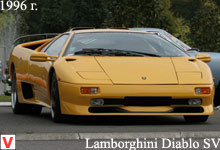
Despite the large amounts spent on the changes, production of the VTR of the second modification was stopped in 2000. After that, customers could only order a roadster converted from a coupe, from the tuning studio Koening. In 1996, Lamborghini cars took part in the Phillipe Charriol Super Sport Trophy championship. The stages of the races were held for two years on all known routes of the world - Le Mans, Nürburgring, Nogaro, Vallelunga. Especially for this championship, the racing version of the Diablo SV - SVR (Sport Veloce Racing) was released, which became the first official Lamborghini car for racing in the GT class.
The model was equipped with an engine capacity of 5.7 liters capacity of 540 hp. With him, the car accelerated to 100 km / h in less than 4 seconds. In addition, compared to the base SV, the racing version was 150 kg lighter. Diablo GT1 car created by Lamborghini in collaboration with the French company SAT (Signes Advanced Technology) from Toulon. The purpose of the GT1 was to break the hegemony of the Porsche GT1 on sports tracks. The company SAT, specializing in racing cars, was responsible for aerodynamics, fuel system, cooling system, brakes, and Lamborghini - for assembling the engine.
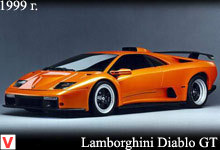
As the base car was taken model Diablo. It was built 2 Diablo GT1, then the project was closed due to trouble in the Lamborghini Automobili. In 1999, at the Geneva Motor Show debuted Diablo GT. The car was released in a limited edition of 80 pieces for sale only in Europe. This modification is famous for the fact that at the time of release was the fastest production machine in the world. She developed 338 km / h. This was made possible by increasing the volume of the V12 engine to 5992 cm ³.
The updated engine had a capacity of 575 hp at 7300 rpm and maximum torque of 630 Nm at 5500 rpm. The new system of individual fuel consumption by each cylinder multi-trottles allowed to increase engine efficiency at medium and high rpm. The engine was supplied with a new noise control system ENCS, based on the work of which channels of variable cross section and two valves, regulated by the engine management system. Aluminum and titanium alloys have found wide use in the engine, which made it possible to significantly reduce its weight.

Almost all parts of the body, excluding the roof and doors, are made of carbon fiber. Wide and low Diablo GT instead of the rear window has a powerful engine air intake, and the glass is replaced by a video camera, which is fixed on the spoiler and transmits the image to a special color monitor in the cabin. Hard seats are trimmed with expensive leather and have a minimal amount of adjustments. For the driver, a leather-trimmed three-spoke steering wheel and a gearshift lever with an aluminum cap are made.
Steering with servo, changing the sensitivity of the steering with increasing speed. Diablo GT was available in 4 colors: orange, titanium silver, black and acid yellow. The Diablo GT could boast an updated body design, a 110 mm increased front track, an improved chassis and braking system with 335 mm ventilated brake discs with ABS, reduced weight, and a new sports interior. At the Bologna Motor Show Lamborghini presented a modification of the Diablo GTR, based on the Diablo GT. Only forty such cars were produced.

In comparison with the Diablo GT, this version has a modified chassis frame directly connected to the rear wing, a sports braking system, reduced weight and a simplified interior. Additional radiators are installed to cool the transmission oil. Under the hood is a boosted 590 horsepower engine. With him, the Diablo GTR accelerated to 348 km / h. To cool the engine, they installed two water radiators on its sides, a fuel radiator in the front, like in the Diablo GT and additional refrigerators for the gearbox mounted on the rear axle.
The front suspension has become tougher. A special racing fuel tank with a fast filling system was installed. Most of the body parts are made of carbon fiber, only the roof was made of steel to increase the longitudinal rigidity and the door of aluminum alloy for security reasons. The car was equipped with a fire extinguishing system, the cab joints were simplified, the driver's seat with a six-point safety belt was moved to the longitudinal axis of the car, for better stabilization.
After the acquisition of Lamborghini by Audi AG, it was decided to make a number of changes in the design of the car, to increase revenue, until the replacement of this model - the Lamborghini Murciélago - is ready. This was the last major car redesign. The changes affected both the exterior and the design - the front bumper, air intakes, the dashboard, the seats changed once again. Now Diablo got the index VT 6.0. The 6-liter car engine, inherited from the Diablo GT, received corrections in the control unit program (ECU), fuel and exhaust systems, valve control, a variable intake valve system.
Diablo VT 6.0 was produced from 2000 to 2001.

